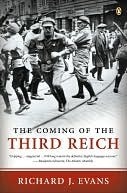More on this book
Community
Kindle Notes & Highlights
Read between
October 9 - November 15, 2024
From this point onwards, the party directed its venom principally against the Social Democrats. Every German government in its eyes was ‘fascist’; fascism was the political expression of capitalism; and the Social Democrats were ‘social fascists’ because they were the main supporters of capitalism, taking workers away from revolutionary commitment and reconciling them to Weimar’s ‘fascist’ political system. Anyone in the leadership who tried to question this line was dismissed from his party post. Anything that would help overthrow the ‘fascist’ state and its Social Democratic supporters was
...more
Between 1929 and 1933, per capita consumption of beer in Germany fell by 43 per cent, and in these circumstances the better-funded brownshirts moved in.
For all the speculation of contemporaries, and some later historians, about the special reasons why women might have voted Nazi - ranging from their supposed greater susceptibility to the emotional appeal of the Party’s propaganda to their alleged disillusion with the Republic for failing to bring them equality - the fact is that there is no indication that they cast their votes for any different reasons than those which led men to support the Party.
Moreover, technically he was not even allowed to stand since he had not yet acquired German citizenship. Hurried arrangements were made for him to be appointed as a civil servant in Braunschweig, a measure that automatically gave him the status of a German citizen, confirmed when he took the oath of allegiance (to the Weimar constitution, as all civil servants had to) on 26 February 1932.
The new government, declared Goebbels at a press conference on 15 March 1933, will not be satisfied for long with the knowledge that it has 52 per cent behind it while terrorising the other 48 per cent but will, by contrast, see its next task as winning over that other 48 per cent for itself ... It is not enough to reconcile people more or less to our regime, to move them towards a position of neutrality towards us, we want rather to work on people until they have become addicted to us ...9
But room for manoeuvre seemed to be supplied by the fact that Expressionism was well regarded by some within the Party, including the Nazi Students’ Union in Berlin, which actually mounted an exhibition of German art in July 1933 that included work by Barlach, Macke, Franz Marc, Nolde, Christian Rohlfs and Karl Schmidt-Rottluff.
Hitler especially detested Nolde’s work, which Goebbels, whose taste was more catholic, rather admired; when the Nazi leader inspected the Propaganda Minister’s new house in Berlin in the summer of 1933, he was horrified to see ‘impossible’ pictures by Nolde hanging on the walls and ordered them to be removed immediately. Nolde was expelled from the Prussian Academy of Arts, to his considerable chagrin, since he had been a member of the Nazi Party virtually since its foundation in 1920.
Many historians have argued that these values were essentially pre-industrial, or pre-modern. Yet this argument rests on a simplistic equation of democracy with modernity.
Article 48 of the Weimar constitution, in particular, which gave the President the power to rule by decree in time of emergency, had never been intended to be the basis for any more than purely interim measures; the Nazis made it into the basis for a permanent state of emergency that was more fictive than real and lasted in a technical sense all the way up to 1945.
It was indeed unfortunate that President Ebert had made such liberal use and broad application of Article 48 earlier in the Republic’s history, and doubly so that Reich Chancellors Brüning, Papen and Schleicher had relied on it so heavily in the crisis of the early 1930s.


